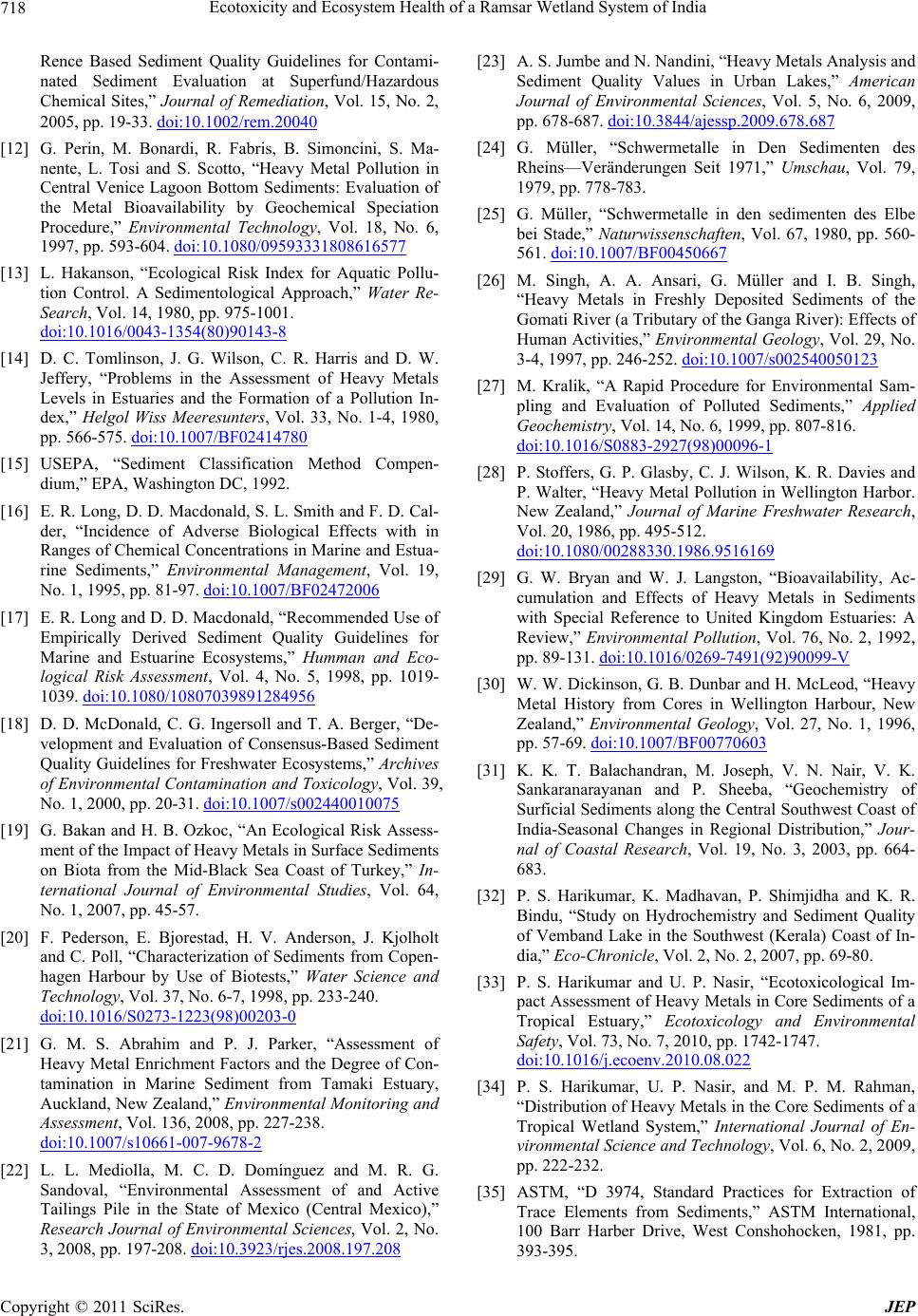
Ecotoxicity and Ecosystem Health of a Ramsar Wetland System of India
718
Rence Based Sediment Quality Guidelines for Contami-
nated Sediment Evaluation at Superfund/Hazardous
Chemical Sites,” Journal of Remediation, Vol. 15, No. 2,
2005, pp. 19-33. doi:10.1002/rem.20040
[12] G. Perin, M. Bonardi, R. Fabris, B. Simoncini, S. Ma-
nente, L. Tosi and S. Scotto, “Heavy Metal Pollution in
Central Venice Lagoon Bottom Sediments: Evaluation of
the Metal Bioavailability by Geochemical Speciation
Procedure,” Environmental Technology, Vol. 18, No. 6,
1997, pp. 593-604. doi:10.1080/09593331808616577
[13] L. Hakanson, “Ecological Risk Index for Aquatic Pollu-
tion Control. A Sedimentological Approach,” Water Re-
Search, Vol. 14, 1980, pp. 975-1001.
doi:10.1016/0043-1354(80)90143-8
[14] D. C. Tomlinson, J. G. Wilson, C. R. Harris and D. W.
Jeffery, “Problems in the Assessment of Heavy Metals
Levels in Estuaries and the Formation of a Pollution In-
dex,” Helgol Wiss Meeresunters, Vol. 33, No. 1-4, 1980,
pp. 566-575. doi:10.1007/BF02414780
[15] USEPA, “Sediment Classification Method Compen-
dium,” EPA, Washington DC, 1992.
[16] E. R. Long, D. D. Macdonald, S. L. Smith and F. D. Cal-
der, “Incidence of Adverse Biological Effects with in
Ranges of Chemical Concentrations in Marine and Estua-
rine Sediments,” Environmental Management, Vol. 19,
No. 1, 1995, pp. 81-97. doi:10.1007/BF02472006
[17] E. R. Long and D. D. Macdonald, “Recommended Use of
Empirically Derived Sediment Quality Guidelines for
Marine and Estuarine Ecosystems,” Humman and Eco-
logical Risk Assessment, Vol. 4, No. 5, 1998, pp. 1019-
1039. doi:10.1080/10807039891284956
[18] D. D. McDonald, C. G. Ingersoll and T. A. Berger, “De-
velopment and Evaluation of Consensus-Based Sediment
Quality Guidelines for Freshwater Ecosystems,” Archives
of Environmental Contamination and Toxicology, Vol. 39,
No. 1, 2000, pp. 20-31. doi:10.1007/s002440010075
[19] G. Bakan and H. B. Ozkoc, “An Ecological Risk Assess-
ment of the Impact of Heavy Metals in Surface Sediments
on Biota from the Mid-Black Sea Coast of Turkey,” In-
ternational Journal of Environmental Studies, Vol. 64,
No. 1, 2007, pp. 45-57.
[20] F. Pederson, E. Bjorestad, H. V. Anderson, J. Kjolholt
and C. Poll, “Characterization of Sediments from Copen-
hagen Harbour by Use of Biotests,” Water Science and
Technology, Vol. 37, No. 6-7, 1998, pp. 233-240.
doi:10.1016/S0273-1223(98)00203-0
[21] G. M. S. Abrahim and P. J. Parker, “Assessment of
Heavy Metal Enrichment Factors and the Degree of Con-
tamination in Marine Sediment from Tamaki Estuary,
Auckland, New Zealand,” Environmental Monitoring and
Assessment, Vol. 136, 2008, pp. 227-238.
doi:10.1007/s10661-007-9678-2
[22] L. L. Mediolla, M. C. D. Domínguez and M. R. G.
Sandoval, “Environmental Assessment of and Active
Tailings Pile in the State of Mexico (Central Mexico),”
Research Journal of Environmental Sciences, Vol. 2, No.
3, 2008, pp. 197-208. doi:10.3923/rjes.2008.197.208
[23] A. S. Jumbe and N. Nandini, “Heavy Metals Analysis and
Sediment Quality Values in Urban Lakes,” American
Journal of Environmental Sciences, Vol. 5, No. 6, 2009,
pp. 678-687. doi:10.3844/ajessp.2009.678.687
[24] G. Müller, “Schwermetalle in Den Sedimenten des
Rheins—Veränderungen Seit 1971,” Umschau, Vol. 79,
1979, pp. 778-783.
[25] G. Müller, “Schwermetalle in den sedimenten des Elbe
bei Stade,” Naturwissenschaften, Vol. 67, 1980, pp. 560-
561. doi:10.1007/BF00450667
[26] M. Singh, A. A. Ansari, G. Müller and I. B. Singh,
“Heavy Metals in Freshly Deposited Sediments of the
Gomati River (a Tributary of the Ganga River): Effects of
Human Activities,” Environmental Geology, Vol. 29, No.
3-4, 1997, pp. 246-252. doi:10.1007/s002540050123
[27] M. Kralik, “A Rapid Procedure for Environmental Sam-
pling and Evaluation of Polluted Sediments,” Applied
Geochemistry, Vol. 14, No. 6, 1999, pp. 807-816.
doi:10.1016/S0883-2927(98)00096-1
[28] P. Stoffers, G. P. Glasby, C. J. Wilson, K. R. Davies and
P. Walter, “Heavy Metal Pollution in Wellington Harbor.
New Zealand,” Journal of Marine Freshwater Research,
Vol. 20, 1986, pp. 495-512.
doi:10.1080/00288330.1986.9516169
[29] G. W. Bryan and W. J. Langston, “Bioavailability, Ac-
cumulation and Effects of Heavy Metals in Sediments
with Special Reference to United Kingdom Estuaries: A
Review,” Environmental Pollution, Vol. 76, No. 2, 1992,
pp. 89-131. doi:10.1016/0269-7491(92)90099-V
[30] W. W. Dickinson, G. B. Dunbar and H. McLeod, “Heavy
Metal History from Cores in Wellington Harbour, New
Zealand,” Environmental Geology, Vol. 27, No. 1, 1996,
pp. 57-69. doi:10.1007/BF00770603
[31] K. K. T. Balachandran, M. Joseph, V. N. Nair, V. K.
Sankaranarayanan and P. Sheeba, “Geochemistry of
Surficial Sediments along the Central Southwest Coast of
India-Seasonal Changes in Regional Distribution,” Jour-
nal of Coastal Research, Vol. 19, No. 3, 2003, pp. 664-
683.
[32] P. S. Harikumar, K. Madhavan, P. Shimjidha and K. R.
Bindu, “Study on Hydrochemistry and Sediment Quality
of Vemband Lake in the Southwest (Kerala) Coast of In-
dia,” Eco-Chronicle, Vol. 2, No. 2, 2007, pp. 69-80.
[33] P. S. Harikumar and U. P. Nasir, “Ecotoxicological Im-
pact Assessment of Heavy Metals in Core Sediments of a
Tropical Estuary,” Ecotoxicology and Environmental
Safety, Vol. 73, No. 7, 2010, pp. 1742-1747.
doi:10.1016/j.ecoenv.2010.08.022
[34] P. S. Harikumar, U. P. Nasir, and M. P. M. Rahman,
“Distribution of Heavy Metals in the Core Sediments of a
Tropical Wetland System,” International Journal of En-
vironmental Science and Technology, Vol. 6, No. 2, 2009,
pp. 222-232.
[35] ASTM, “D 3974, Standard Practices for Extraction of
Trace Elements from Sediments,” ASTM International,
100 Barr Harber Drive, West Conshohocken, 1981, pp.
393-395.
Copyright © 2011 SciRes. JEP